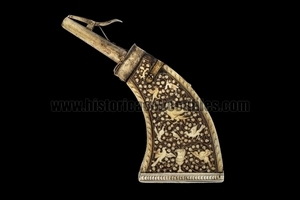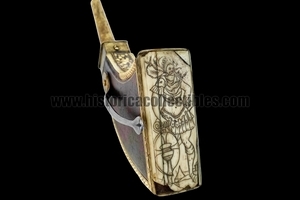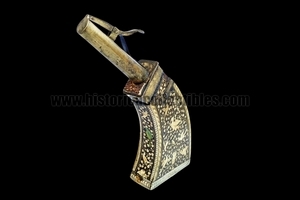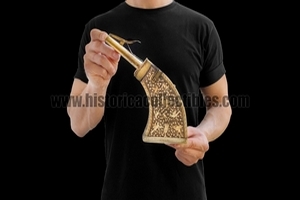Powder Flask or Pulverflaske, Nord Italy (Milan-Brescia), circa 1580
Powder flask or pulverflasche produced around 1580 in Italy, (Brescia or Milan), with a flat and curved shape, is made of fine walnut wood and decorated with engraved ivory, mother-of-pearl and bone inlays.
On the front and on the internal side of the flask, there is a magnificent inlay composed of spirals, engraved flowers and numerous species of birds which, masterfully executed, are made protagonists.
The front and sides of the flask are delimited around the entire perimeter by a frame inlaid in bone which is also identical to the back.
The fittings are made of brass, essential, which should not in any way affect the beauty of the inlay, sublime and difficult to find in other flasks.
Finally, on the bottom of the flask there is a skillfully engraved ivory plaque, depicting a warrior equipped with a shield and with "mannerist" characteristics typical of the 16th century.
It is extremely important to consider that, for the purposes of understanding the subjects created on the flask, starting from the second half of the sixteenth century, there was a flourishing of ornithological writings which certainly significantly influenced the author of this important flask dust. In fact, in 1544, the Englishman William Turner published a Historia Avium (History of Birds) and in 1555, the Swiss Conrad von Gesner, published De Avium Natura (Nature of Birds), immediately translated from Latin into German (Vogelbuch = Book of Birds, 1557), in which 217 species of birds are listed in alphabetical order, each illustrated with a wood engraving and complete with information on appearance, anatomy, distribution and behaviour.
In the same year, the Frenchman Pierre Belon published the Histoire de la Nature des Oyseaux, avec Leurs Descriptions et Naïfs Portraicts Retirez du Naturel (History of the Nature of Birds, with Their Descriptions and Simple Portraits Taken from the Natural), containing descriptions of about two hundred species.
Around 1572 the Dutchman Volcher Coiter, who had studied the internal structures of birds in depth, proposed a classification of these animals based on structure and behavior in De Diferentiis Avium (The Different Birds).
In Italy also, the Bolognese naturalist Ulisse Aldrovandi published a text entitled Ornithologiae Hoc Est de Avibus Historiae Libri XII (Ornithology or History of Birds in 12 Books) in 1599, to which two further volumes were added in 1600 and 1603, for a total of over 2000 pages entirely dedicated to ornithology.
The Umbrian Antonio Valli da Todi published Il Canto de gl'Augelli in 1601, a work in which, among other things, he explains the relationship between territory and song.
In 1676 Francis Willughby published Ornithologiae Libri Tres (Ornithology in 3 Books), later completed by John Ray.
Furthermore, the expansion of trade routes and the colonization of the Americas led to the description of new species. A very important contribution in this sense was given by Charles de l'Écluse, generally known by the Latinized name of Carolus Clusius. Although mainly a botanist, this Frenchman who lived in the Netherlands had the opportunity to see finds from all over the world, brought by navigators, and in 1605 he published Exoticorum Libri Decem (Exotic Things in 10 Books), in which, among other things, many new bird species are described, such as the cassowary, Magellanic penguin, red ibis etc.
Among the many other scholars who described new species, we remember here the Danish Ole Worm (Latinized as Olaus Wormius), who described the bird of paradise and the geographer Georg Markgraf, whose notes were used by Johannes de Laet for the last volume of Historia Naturalis Brasiliae (Natural History of Brazil, 1648), containing 133 species of birds.
References:
Munchen, Bayerische Nationalmuseum (111 884)
Csörge Collection
Victoria And Albert Museum (W.57-1923)
Victoria And Albert Museum (67-1903)
Victoria And Albert Museum (M.143-1923)
Philadelphia Museum of Art (1977-167-914)
Philadelphia Museum of Art (1977-167-917)





